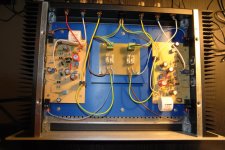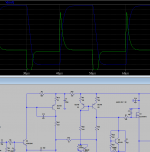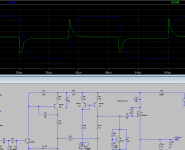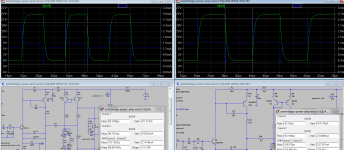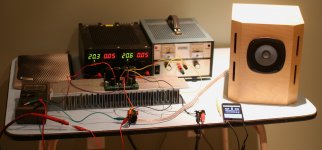Member
Joined 2009
Paid Member
I think a bipolar cap for C3 would be a good choice too. [/url]
I never noticed the mis-orientation of C3 either!
If you issue a revised board for this design (and I hope you do at some stage) then I would suggest increasing the size of C3 significantly. As it stands it has a corner frequency of ~6hz, which is too high I feel if we want to minimise low frequency distortion.
If the footprint were increased to 10mm then a 1m 16V rated polarized cap or 2m2 6V3 could be accomodated, reducing fc dramatically. Particularly in the case of the lower voltage part, it might be prudent to bypass the cap with two pairs of series connected anti-parallel diodes (D. Self). There is a caveat there: my first practical experience with this technique was when building the design here:
http://www.diyaudio.com/forums/solid-state/237839-250w-8ohm-amplifier.html
I used the diodes specified (generic 1n4148) and ended up having offset issues as a result of the diodes stealing current from the LTP base. Reading S. Groner and further experimentation has led me to conclude that low leakage signal diodes (e.g. Fairchild 1N914B or FDH300) are suitable for this purpose.
Thank you for your prompt answer.
In reality I am using your input stage and single pole/transistor VAS.
With 47p Cdom, it sounds incredibly good in the bass but the trebble lacks the subliminar micro detail I am used from other amps, so in the end I get the impression of harshness and lack of spatiality.
I believe that is the signature of compression due to the fact the input transistor not beeing able to charge/discharge Cdom as fast as it should.... That is why I believe reducing this cap would help.
I am quite sure it will be stable with 10p and the BD140 for the VAS, but if I use the KSA (with much lower Cob) I am not sure I can use such a low Cdom.
Using a signal generator and a scope, what should I look for ? should I input 20k squares and look for spikes on the output ?
How can I predict instability with this Equipment ?
Hi RC
The first thing I would do is replace the BD140 with a KSA1381. I have done a lot of listening experiments with both transistor types in the original P3A (which this project is based upon) and very much prefer the KSA1381.
Regarding the TGM8, I have built both the two transistor input (with single pole comp) and three transistor (with two pole comp) versions and prefer the simpler version since I can't hear any difference between the two. In both cases I used lead comp.
I posted some observations while playing around with single pole compensation here:
http://www.diyaudio.com/forums/soli...fier-based-rod-elliot-p3a-23.html#post3756728
I haven't done any further experimentation with the TGM8 compensation; however, my gut feeling is that Bigun is somewhat conservative with these values.
I have posted a similar project here: http://www.diyaudio.com/forums/soli...imentary-mosfet-amplifier-14.html#post4042603) that uses Bigun's front end; the exception being that I've used a compound pair VAS. I have tested it with 12p lead comp and 33p lag comp and it is stable into the speaker loads I've tested.
If I were you I would try it out with the KSA1381 and the 47p miller cap you already have in there, and a small amount of lead comp (say 5-10p) if you are still not happy with the sound then perhaps carefully reduce the miller cap to 33p or even slightly less.
With 47p Cdom, it sounds incredibly good in the bass but the trebble lacks the subliminar micro detail I am used from other amps, so in the end I get the impression of harshness and lack of spatiality.
Picking up on these comments...
I tend to agree that the TGM8 is somewhat less detailed then other designs and this is most noticeable in the treble. In this respect I find the TGM8 similar to most simple circuits, particularly those with only moderate feedback. The sonic signature is similar - albeit and improvement - over the original P3A.
However while this extra "detail" (crispness?) in the treble can make for an impressive short/sharp auditioning experience, it ends up being fatiguing for casual listening or during extended periods. I guess my ears are sensitive to the way the treble is presented that is why I appreciate designs such as these.
I can't understand why you think this one is "harsh" since my experience is the complete opposite.
YMMV

To me this sounds like a classic description of overshoot on fast transients, i.e. amplifying the fastest signals more than the slower signals...............However while this extra "detail" (crispness?) in the treble can make for an impressive short/sharp auditioning experience, it ends up being fatiguing for casual listening or during extended periods. I guess my ears are sensitive to the way the treble is presented that is why I appreciate designs such as these................
Member
Joined 2009
Paid Member
Hi RC
The first thing I would do is replace the BD140 with a KSA1381. I have done a lot of listening experiments with both transistor types in the original P3A (which this project is based upon) and very much prefer the KSA1381.
Regarding the TGM8, I have built both the two transistor input (with single pole comp) and three transistor (with two pole comp) versions and prefer the simpler version since I can't hear any difference between the two. In both cases I used lead comp.
I posted some observations while playing around with single pole compensation here:
http://www.diyaudio.com/forums/soli...fier-based-rod-elliot-p3a-23.html#post3756728
I haven't done any further experimentation with the TGM8 compensation; however, my gut feeling is that Bigun is somewhat conservative with these values.
I have posted a similar project here: http://www.diyaudio.com/forums/soli...imentary-mosfet-amplifier-14.html#post4042603) that uses Bigun's front end; the exception being that I've used a compound pair VAS. I have tested it with 12p lead comp and 33p lag comp and it is stable into the speaker loads I've tested.
If I were you I would try it out with the KSA1381 and the 47p miller cap you already have in there, and a small amount of lead comp (say 5-10p) if you are still not happy with the sound then perhaps carefully reduce the miller cap to 33p or even slightly less.
Thank you so much for your comment.
I will try the KSA1381 but need some explaining on what you mean by lead comp... what is it and where do I put the 5 - 10p ?
Picking up on these comments...
I tend to agree that the TGM8 is somewhat less detailed then other designs and this is most noticeable in the treble. In this respect I find the TGM8 similar to most simple circuits, particularly those with only moderate feedback. The sonic signature is similar - albeit and improvement - over the original P3A.
However while this extra "detail" (crispness?) in the treble can make for an impressive short/sharp auditioning experience, it ends up being fatiguing for casual listening or during extended periods. I guess my ears are sensitive to the way the treble is presented that is why I appreciate designs such as these.
I can't understand why you think this one is "harsh" since my experience is the complete opposite.
YMMV
IMO this front end provides exceptional bass, very well detailed and fast with good presence. in the high frequencies I detect lack of detail and by that I dont mean crispness... My other amps provide much more subliminar micro detail enabling me (us) to capture the 2real" nuances of the recordings.
I do not search for crispness or sharpness..... I just want more sweet microdetail.
Member
Joined 2009
Paid Member
Thank you so much for your comment.
I will try the KSA1381 but need some explaining on what you mean by lead comp... what is it and where do I put the 5 - 10p ?
The lead compensation is C5 and provides some h.f. feedback from the VAS collector to the feedback node. The benefit is that it allows the use of less Cdom. Of course, it's a more complex topic and there's likely to be a lot written about it. It was first recommended to me by Hugh Dean and since then I've noticed it is used by a number of well-regarded designs. There is a spot on the pcb for this capacitor, with a through-hole footprint and an SMD footprint. The SMD allows for a small low-inductance np0 ceramic cap, or the through-hole can be used for an np0 ceramic cap or for those with ceramic allergies you can squeeze in a silver-mica. In my build I used an np0 cap.
I don't have the experience or the 'ears' you have so I can't help you search for this last few drops of performance. I'm not sure what factors might affect it. The compensation is likely a key one but there may also be other factors (local compensation of the CFP, choice of zobel/input/feedback/bootstrap caps, choice of active devices etc. etc.). So we are going to hitch our wagons to your train to find out what the secret is - please keep this up it's much appreciated, it can be a lot of work.
Last edited:
Many British amplifier designers use this lead compensation.
So much so that most delete Cdom completely leaving only the VAS Cob there.
But those that do this also have quite a few other compensation components some including resistances in series with the extra capacitors. Is this adding zeros?
So much so that most delete Cdom completely leaving only the VAS Cob there.
But those that do this also have quite a few other compensation components some including resistances in series with the extra capacitors. Is this adding zeros?
I dropped the Cdom and phase lead down to 22p and 10p, respectively, on one of my spare TGM8 boards. This with a KSA1381 VAS transistor. No signs of oscillation but I dared not go lower. I can't be sure whether it sounded better or worse than before - either way it sure sounds great to me 

I dropped the Cdom and phase lead down to 22p and 10p, respectively, on one of my spare TGM8 boards. This with a KSA1381 VAS transistor. No signs of oscillation but I dared not go lower. I can't be sure whether it sounded better or worse than before - either way it sure sounds great to me
This looks perfect to me.
I will do that and report results soon
I believe in my actual build (with 47p Cdom and BD140) the input transistor is having difficulties charging Cdom at high frequencies so there is compression.... Lowish slew rate issues.
Simulation shows compression on the negative spikes of the current on the collector of the input device.
Simulation shows compression on the negative spikes of the current on the collector of the input device.
Attachments
Now look at what I got when using the lower Cob KSA and the latest suggestion for Cdom and Clead.....
Much better spike symmetry and the lowest point of the curve does not reach zero possibly indicating no compression.
On the left you can see the simulation with 8mA current on the VAS and on the right the "normal" 5mA version.
I do not know if there is any sonic benefit but I was instructed that the VAS should run at highish currents so I am inclined to try the HC high current version.
Much better spike symmetry and the lowest point of the curve does not reach zero possibly indicating no compression.
On the left you can see the simulation with 8mA current on the VAS and on the right the "normal" 5mA version.
I do not know if there is any sonic benefit but I was instructed that the VAS should run at highish currents so I am inclined to try the HC high current version.
Attachments
Member
Joined 2009
Paid Member
I can't be sure whether it sounded better or worse than before - either way it sure sounds great to me
Sometimes it takes a lot of cumulative tweaks to add up to an overall change, something you can perceive and maybe not even describe. Glad you are still enjoying the amplifier.
I've not had time to work with mine. It requires some sustained hobby-time and this year the best I can do is a bit here and a bit there. As a consequence my own original TGM8 is not finished, no chassis prepared etc.
Today is Canadian Thanksgiving holiday and I found a couple of hours to install the power devices in the 2nd channel, clean up the board of solder flux. I've made the 'LED fix' and swapped around the orientation of C3 on both channels so they're both fully functional.
I also powered up both boards on a bench supply at +/-40V rails to ensure dc-offset and bias were at reasonable settings. I had a chance to listen to a bit of music through my sons iPod and my Moon Onken speaker - the first time I've heard the amplifier this year - it still sounds good even with an iPod
RC - you're making great progress ! keep going with the fine tuning, it looks to be all in the right direction.
Attachments
Last edited:
- Home
- Amplifiers
- Solid State
- TGM8 - my best amplifier, incredible bass, clear highs, no fatigue (inspired by Rod Elliot P3a)
